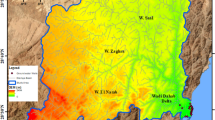Abstract
This study focuses on the infiltration of saturated brine from liquid-waste storage facilities into the surrounding groundwater and surface-water bodies. The storage facilities are situated at the Verkhnekamsk Potassium and Magnesium Salt Deposit (Perm krai, Russian Federation); they store highly mineralized brine of potassium, sodium, and magnesium chlorides. An analytical solution of a one-dimensional equation of contaminant transport by a homogeneous steady-state groundwater flow is used to estimate the time it takes the contaminant to travel from the storage facilities to the nearest surface water body, as well as to evaluate the formation time of a stationary concentration profile, with contaminant adsorption in the porous matrix either neglected or taken into account. The contaminant concentration at the point of brine entry into the surface water body is calculated. The ANSYS Fluent software package is used for direct 3D simulation of brine infiltration into the surrounding medium. The simulation results revealed different stages of contaminant propagation in the porous medium. The contaminant was found to spread over a wide area with an almost uniform high brine concentration close to the saturation value. The contaminant reaches the nearest riverbed approximately 20 days after the start of infiltration. The estimates of the time required for the contaminant front to reach the surface water body obtained by three-dimensional simulation agree with the analytical estimates derived from a one-dimensional model. The proposed system of physical models adequately describes the hydrodynamic processes accompanying the operation of large storage facilities and can be used to predict contaminant-front propagation in the groundwater near storage facilities.
Similar content being viewed by others
References
Delleur, J.W., The Handbook of Groundwater Engineering, Boca Raton, FL: CRC, 2006.
Berkowitz, B., Dror, I., and Yaron, B., Contaminant Geochemistry, Berlin: Springer, 2008.
Lick, W., Sediment and Contaminant Transport in Surface Waters, Boca Raton, FL: CRC, 2009.
Makashov, S.E. and Potapov, A.A., Numerical modeling of the influence of accidental flooding of the salt mine BKPRU-1 on brine migration in the above-salt complex, Estestv. Tekh. Nauki, 2012, no. 2, pp. 201–205.
Ban’kovskaya, V.M. and Konstantinova, S.A., Hydrogeological aspects of formation of land surface collapses in the minefield of the Berezniki-1 potash mine, Vestn. Mezhdun. Akad. Nauk Ekol., Bezopasn. Cheloveka Prirody, 2000, no. 6, pp. 60–62.
Liu, Yu. and Lekhov, A.V., Modeling of filtration parameters of gypsiferous rocks upon brine filtration, Geoekologiya, 2012, no. 6, pp. 551–559.
Franz, T.J. and Rowe, R.K., Simulation of groundwater flow and contaminant transport at a landfill site using models, Int. J. Numer. Anal. Methods Geomech., 1993, vol. 17, no. 7, pp. 435–455.
Polubarinova-Kochina, P.Ya., Theory of Ground Water Movement, Princeton: Princeton Univ. Press, 1962.
Bear, J. and Cheng, A.H.D., Modeling Groundwater Flow and Contaminant Transport, Amsterdam: Springer, 2010.
Anderson, M.P. and Woessner, W.W., Applied Groundwater Modeling: Simulation of Flow and Advective Transport, New York: Academic, 1992.
Lepikhin, A.P., Lyubimova, T.P., Parshakova, Ya.N., and Tiunov, A.A., Discharge of excess brine into water bodies at potash industry works, J. Mining Sci., 2012, vol. 48, no. 2, pp. 390–397.
Bachurin, B.A. and Baboshko, A.J., On the nature of transformation of the composition of anthropogenic-mineral formations of mining manufacture under hypergenesis conditions, Gorn. Inform.-Anal. Byull., 2010, no. 7, pp. 336–342.
Chen, B., Water pollution simulation and health risk assessment through a refined contaminant transport model, Water Air Soil Pollut., 2009, vol. 200, nos. 1–4, pp. 323–339.
Hall, L.W.Jr., Ziegenfuss, M.C., Fischer, S.A., Sullivan, J.A., and Palmer, D.M., The influence of contaminant and water quality conditions on larval striped bass in the Potomac River and upper Chesapeake Bay in 1990: an in situ study, Arch. Environ. Contam. Toxicol., 1993, vol. 24, no. 1, pp. 1–10.
Nield, D.A. and Bejan, A., Convection in Porous Media, Berlin: Springer, 2013.
Vafai, K., Handbook of Porous Media, Boca Raton, FL: Taylor and Francis, 2005.
Barrenblatt, G.E., Zheltov, I.P., and Kochina, I.N., Basic concepts in the theory of seepage of homogeneous liquid in fissured rocks, J. Appl. Math. Mech., 1960, vol. 24, no. 5, pp. 1286–1303.
Barenblatt, G.I., Entov, V.M., and Ryzhik, V.M., Teoriya nestatsionarnoj fil’tratsii zhidkosti i gaza (Theory of Unsteady Filtration of Fluids and Gases), Moscow: Nedra, 1972.
Lepikhin, A.P. and Miroshnichenko, S.A., Anthropogenic impact of the Solikamsk-Berezniki industrial cluster on surface water bodies, Gorn. Zh., 2008, no. 10, pp. 92–96.
Lepikhin, A.P., Lyubimova, T.P., Parshakova, Ya.N., and Tiunov, A.A., On the issue of disposal of potassium production excessive brines to water bodies by potassium-producing plants, Vodn. Khoz-vo Rossii. Probl., Tekhnol., Upravl., 2010, no. 3, pp. 57–74.
Lyubimova, T.P., Lepikhin, A.P., Parshakova, Ya.N., and Tiunov, A.A., Numerical modeling of dilution and transport of highly mineralized brines in turbulent flows, Vychisl. Mekh. Sploshnykh Sred, 2010, no. 4, pp. 68–79.
Maximovich, N.G. and Pervova, M.S., Influence of the mineralized water crossflows of the Upper-Kama potash-magnesium salt deposit on the subsurface hydrosphere, Inzh. Izyskaniya, 2012, no. 1, pp. 22–26.
Lepikhin, A.P., Lyubimova, T.P., Parshakova, Ya.N., and Tiunov, A.A., Combined approach to the description of density stratification effects in the dilution and transport of highly brines in water bodies, Vestn. Perm. Univ., Ser.: Mat. Mekh. Inform., 2011, vol. 9, no. 5, pp. 130–134.
Polyanin, A.D., Handbook of Linear Partial Differential Equations for Engineers and Scientists, Boca Raton, FL: CRC, 2001.
van Genuchten, M.Th. and Šimunek, J., Evaluation of pollutant transport in the unsaturated zone, in Regional Approaches to Water Pollution in the Environment, Rijtema, P.E. and Eliáš, V., Eds., NATO ASI Series 2: Environment, Dordrecht: Kluwer, 1996, pp. 139–172.
Author information
Authors and Affiliations
Corresponding author
Additional information
Original Russian Text © T.P. Lyubimova, A.P. Lepikhin, Ya.N. Parshakova, K.B. Tsiberkin, 2015, published in Vychislitel’naya Mekhanika Sploshnykh Sred, 2015, Vol. 8, No. 3, pp. 310–318.
Rights and permissions
About this article
Cite this article
Lyubimova, T.P., Lepikhin, A.P., Parshakova, Y.N. et al. Numerical modeling of liquid-waste infiltration from storage facilities into surrounding groundwater and surface-water bodies. J Appl Mech Tech Phy 57, 1208–1216 (2016). https://doi.org/10.1134/S0021894416070099
Received:
Accepted:
Published:
Issue Date:
DOI: https://doi.org/10.1134/S0021894416070099




